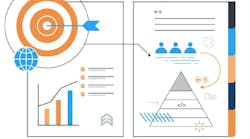Leadership on Point: Managing through the Generational Divide
IndustryWeek's elite panel of regular contributors.
It’s hard to keep them all straight – the Silent Generation, baby boomers, Gen Xers, GenZers, baby busters, millennials, iGen, Gen Alpha. Regardless of what you call them, or who falls into which generation, the issue is the same. How do we lead multiple generations in the workforce with different values, work styles and motivations?
I am increasingly working with manufacturing companies in need of navigating culture issues that arise from a multi-generational team. Those leaders who understand the differences each generation brings to a workplace can learn to create a culture where all generations flourish together.
Joe Yanda, a Gen Xer at 45 years old, is CEO of Lakeside Foods—an industry-leading producer of frozen and canned vegetables in Manitowoc, Wisconsin. He stepped into the CEO role in May 2021 and is the fourth generation of family members to run the company. Joe, who is one of our clients, is challenged with both managing older generations on the board, and the younger ones in the workforce.
“I personally love engaging a broad range of generations for key discussions about where the company is heading and how the culture feels,” Yanda told me. “I get a kick out of hearing their perspectives because they are so different from my own.”
What Are the Major Differences Between Generations?
Hierarchy & Chain of Command: The differences in values and motivations show up in many ways in the workplace. For example, how people relate to the hierarchy and chain of command. Younger generations don’t understand the traditional hierarchy within a company, something Yanda has observed. They wonder why they have to start out in a cubicle and work their way up the ladder to a large office with a nice desk. “It doesn’t make sense to them and it’s not what motivates them,” said Yanda.
“In the past, employees would also be hesitant to come to me as the CEO with concerns or questions. Now I see a lot of younger employees coming to me directly if they have a concerns and questions.” Indeed, that can be hard for their managers and others who feel the chain of command is important to follow and a rite of passage to be able to talk to the CEO directly.
Desired Culture & Workspaces: There are also differences in what is desired in the culture, including the office space. “The younger generation has such a different perspective of even the office space they would like to have versus a baby boomer or Gen-X’er,” explains Yanda. “They want flexibility in where they work, how they work and even the furniture they work in. As we redo our office space, we need to take all of these perspectives into account.”
Work-Life Expectations: Perhaps one of the most challenging differences to navigate is that younger generations are often described as not as “loyal” to their company as previous generations. However, what if this was not really about loyalty at all, but more about the expectations younger generations have about the work experience? This difference often gets labelled as a lack of loyalty, which misses the bigger picture.
Younger generations also have different expectations about work-life balance and the amount of flexibility that is offered to them.
In terms of the evolution of organizations, expecting, or even forcing, more flexibility is not a bad thing. These are positive shifts in an organization’s evolution. It’s easy to label younger generations as “difficult” or “less loyal” when in reality they are helping us grow and change our companies for the better. Perhaps they are only less loyal when viewed through the lens that is the mindset of older generations. They are redefining what loyalty means at work.
How Do You Manage Multiple Generations?
Having multiple generations in a workforce is an opportunity to grow an organization’s collective thinking and capabilities. Younger people challenge the status quo of the longer-tenured employees. In return, more experienced employees have a lot to offer to younger generations. Leaders can’t expect only one generation to change to suit the needs of the other. It has to be a give and take if the entire organization is going to benefit.
At Lakeside Foods, “Our oldest employee manages our youngest employee and does a fabulous job,” says Yanda. “This manager is the textbook example of how to be open and listen and make others feel empowered, heard, and that what they are doing is important. It’s partly his personality, but he also places a high value on mentorship and passing his legacy on to the younger generation.”
The principles for managing multiple generations are really the same principles of good leadership. We have to be flexible, create meaning, resolve conflicts constructively, and be willing to listen to each other.
What’s Important:
A flexible management style
- Good conflict resolution techniques
- The ability to communicate, and share the “why”
- A focus on multiple dimensions of culture
- Adaptive solutions to fit emerging needs
Lakeside Foods embarked on its cultural journey after its leadership found “some of the older workers were having trouble managing some of the younger employees and having them feel valued and heard,” Yanda said. “They had different values and motivations.”
At Lakeside, like at many long-standing manufacturing businesses, working overtime and “doing whatever it takes” is a badge of pride. Legacy employees are accustomed to forfeiting their personal lives during the summer vegetable pack season. However, the younger workforce is not willing to do that and feels there is “something wrong with it.” This can lead to tension between the different generations. It’s easy to think the other one is wrong. The managers and supervisors who make it work are willing to be flexible and work through conflicts constructively. “The conflict forces us to innovate, change and adapt,” said Yanda.
For example, this year for the first time, plant leaders killed a sacred cow and were willing to look at different schedules for different individuals. It complicates the process, but they realized it was essential to meet the needs of the workforce. They are also looking at how to automate parts of the process that have never been automated in the past. In a company, and an industry, where process and efficiency is king, they are having to reinvent they way they run their manufacturing operation in order to adjust to different generational needs.
While it is not easy, it is certainly worth figuring out how to manage through the different values and motivations. “The multiple generations drive innovation because of the differences in perspective on pretty much everything,” Yanda explains. “Developing a healthy talent pipeline by having multiple generations, especially in our business, is critical. We have found success in having a mix of employees we groom and bring up through the talent pipeline.”
Carolyn Hendrickson, Ph.D. is CEO and founding partner of Tandem Group, a firm that specializes in strategy, organization, and leadership. She has over 30 years of experience in working with senior executives and their boards to achieve and sustain breakthrough results in their businesses through accelerated growth and change. Her primary areas of expertise are in strategic planning, senior leadership team alignment, and cultural transformation.





